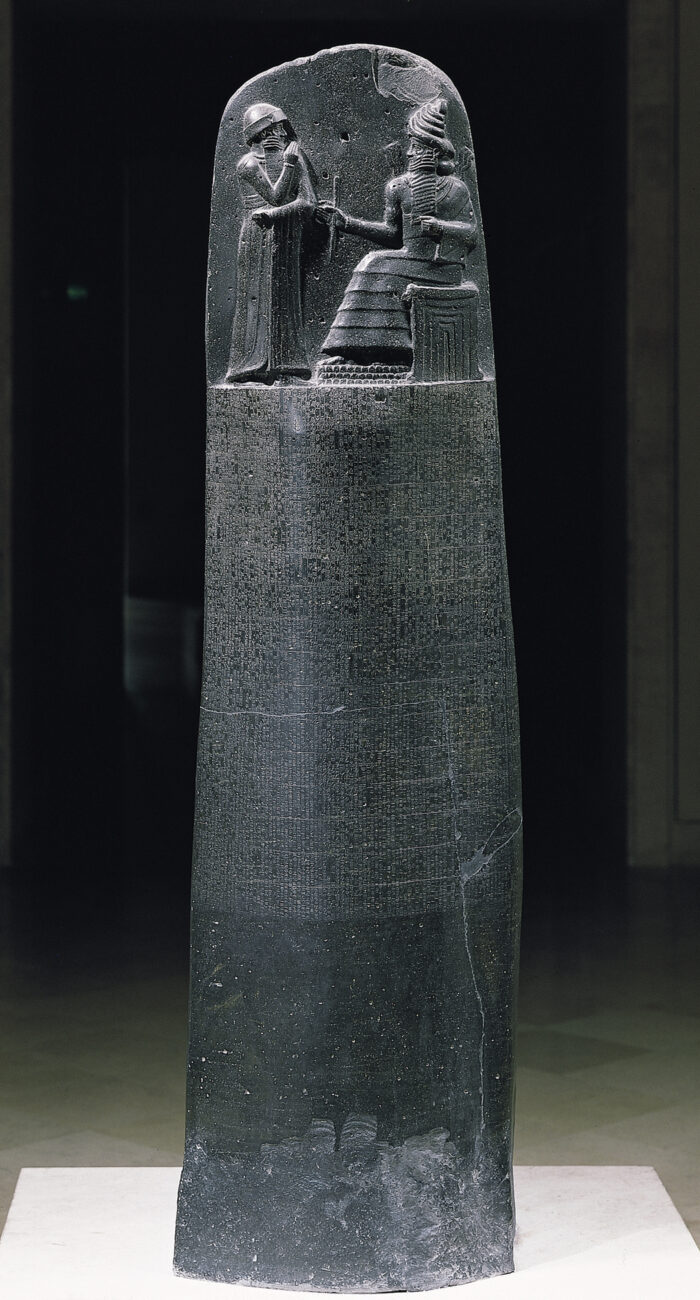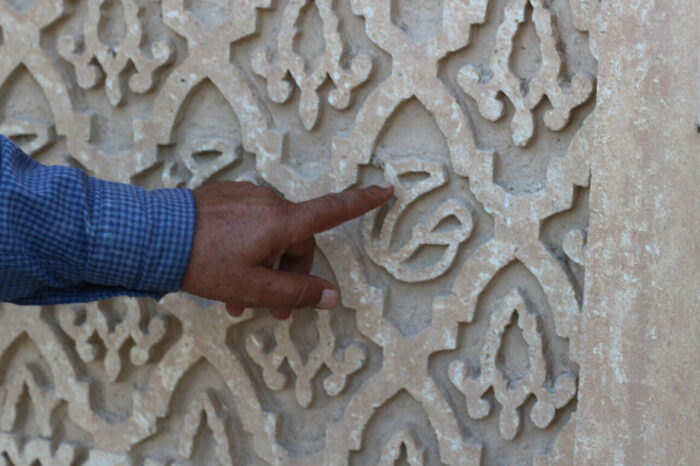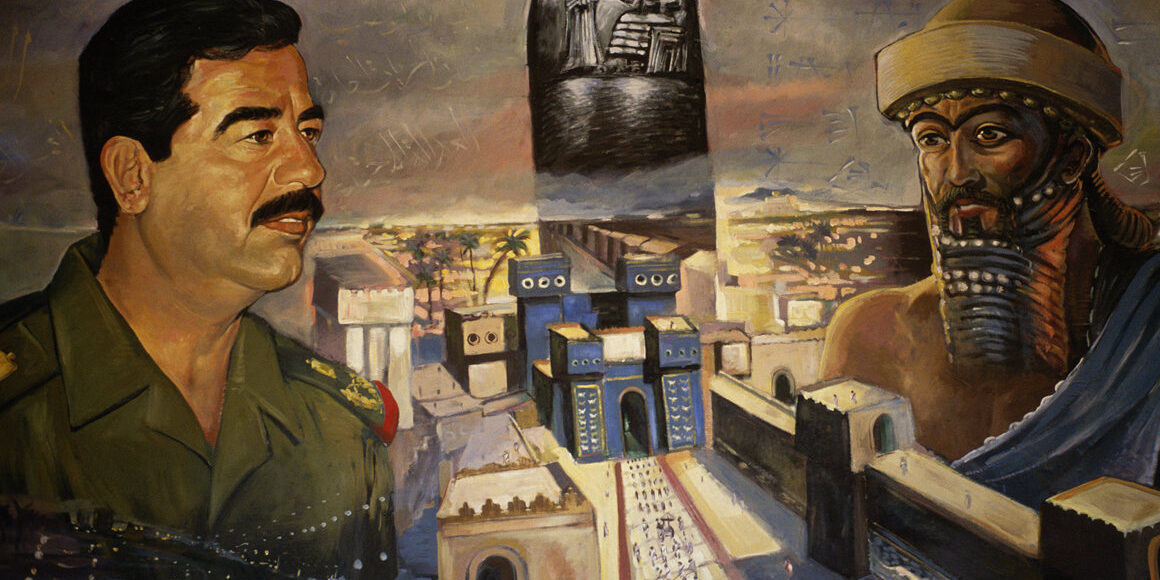In the image above, some of you may not know the specific figure that Iraqi dictator, Saddam Hussein is looking at, however most you may recognize the object depicted in the upper background as the famous art piece, “The Law Code of Hammurabi”. Being aware of this detail, may give you an idea of the story that the painting is trying to tell. Keep your eyes peeled as this ancient Mesopotamian art piece also has great significance in the “Love Story of Saddam Hussein and the Mesopotamia Civilization.”
The obsession that Saddam Hussein once had with the civilization of Mesopotamia and its practices of rule and power, is the type of obsessive behavior that many of us may have experienced when seeing our High School crushes for the first time, but our admiration probably didn’t go as far as attempting to become our crush, replicating all of the tendencies that made us crush on them in the first place (at least I hope not!). Less than a week after taking full control of Iraq in 1979, Hussein called for an assembly of the Ba’ath party, meaning “renaissance” or “resurrection” party in Arabic. This was just the beginning of making his fantasy love for the position of heir to the Mesopotamian throne a reality.
How to Love (Rule)
Through his narcissistic and grandiose personality, Saddam Hussein wanted to be seen as a king, just like his fantasy love of the Mesopotamian system that had its own king with absolute power over their people. During his entire term of power, the government of Iraq had been a dictatorship dominated by the only officially recognized party, the Ba’ath Party. The people, like the ordinary Mesopotamian citizens, had no voice and much like the Mesopotamian kings, Saddam ensured that no one either became too prominent or popular by jailing or murdering anyone who did. Cue the significance of the famous Mesopotamian art piece, “The Law Code of Hammurabi“!

The Law Code of Hammurabi was one of the earliest and most complete written legal codes, proclaimed by the Babylonian King, Hammurabi. The Mesopotamian stele was a collection of 282 rules that established standards for commercial interactions and set fines and harsh punishments, sometimes demanding the removal of the guilty party’s tongue, breasts, eye or even ear, to meet the requirements of justice. To explain its immense significance in this “love story”, the law code is direct evidence of the strict order that Mesopotamian rulers had on their people, in which Hussein wanted to emulate on his own.
By 1990, Hussein had created the most extensive and vast governmental security structures in modern history just as the Mesopotamian Kings established theirs in antiquity. Furthermore, his government had available to it much more developed technologies and techniques, enabling it to reach society to a far greater height than the rulers of Mesopotamia ever did.
(Re)Building Love
In the 1980’s during the Iran-Iraq war, Saddam’s crazed love obsession with Mesopotamian rule grew even more as he became so attracted to Babylonian ruler, Nebuchadnezzar. His obsession with the past ruler became so out of hand that he started to believe that he himself was the modern reincarnation of Nebuchadnezzar, and to prove it, he spent millions building a gigantic construction of Babylon. To start with this reconstruction, Hussein wanted a palace to be the cornerstone of his works on remaking Babylon. He siphoned millions of his people into the rebuilding, and pushed to have the reconstructions built on the foundations of the original site of Babylon in Qawarish, a village on the end of the Tigris River.
His palace at Babylon is the clearest depiction of the narcissistic and grandiose personality that he manifested. It’s carved with Arabic calligraphy that at first glance, resembles religious iconography, but upon a closer look reveals itself to be Saddam Hussein’s initials.

Continuing on the path of replicating his fantasy love for the rule of Mesopotamia, when Saddam heard that Nebuchadnezzar had stamped the bricks of ancient Babylon with his name and titles, he ordered that reconstruction completely mimic this practice. To this day, behind the palace scores of bricks are stamped with a declaration: “In the reign of the victorious Saddam Hussein, the president of the Republic, may God keep him the guardian of the great Iraq and the renovator of its renaissance and the builder of its great civilization”.
Maintaining Love (Power)
Now that his envisioned fantasy was almost fully reality, in order to maintain it for as long as he possibly could Saddam used propaganda to influence his people and depict him as the king that he ever so dreamed of being. If you haven’t guessed already, the propaganda that he produced was directly influenced by the ideas of ancient Mesopotamian art; a similar comparison that is much like what we saw earlier with the influence that “The Law Code of Hammurabi” had on his style of rule over Iraq.

The Victory Stele of Naram-sin, depicts King Naram-sin as a god-like, bigger than life figure. From the background of this particular art piece, the Akkadian King led his troops to victory over the steep slopes of the enemy territory, mercilessly crushing all resistance. Something to take note of in the artwork is the immense gore that it depicts with figures seen to be falling to their eventual death.

In the propaganda piece that we see above, Hussein is depicted with the same god-like, bigger than life appearance, leading his people and military to “victory”, very similar to the actions of the Akkadian King. Although not as gory as the ancient Mesopotamian art piece, this propaganda piece seems to show its own version with its copious amount of weaponry and symbols of violence and war.
This love story although, very unordinary, is something of great intricate measure. Hussein used everything (literally) in his power to recreate his envisioned admiration of Mesopotamian rule.
Kwame Grant
Author
Kwame is from Ridgewood, New Jersey and is a part of the Colgate Class of 2024. Although currently undecided, he has interests in majoring in Physics for Engineering with a minor in African Studies.
